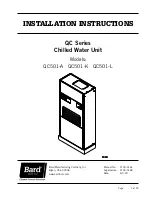
EWLP012~065KBW1N
Condenserless water-cooled water chillers
4PW61665-1 – 07.2010
Installation manual
3
S
ELECTION
OF
PIPING
MATERIAL
1
Foreign materials inside pipes (including oils for fabrication)
must be 30 mg/10 m or less.
2
Use the following material specification for refrigerant piping:
-
construction material: Phosphoric acid deoxidized seamless
copper for refrigerant.
-
size: Determine the proper size referring to
-
the pipe thickness of the refrigerant piping must comply with
relevant local and national regulations. For R407C the design
pressure is 3.3 MPa.
3
In case the required pipe sizes (inch sizes) are not available, it is
also allowed to use other diameters (mm sizes), taken the
following into account:
-
select the pipe size nearest to the required size.
-
use the suitable adapters for the change-over from inch to
mm pipes (field supply).
C
ONNECTING
THE
REFRIGERANT
CIRCUIT
Precautions when handling piping
If air, moisture or dust gets in the refrigerant circuit, problems may
occur. Therefore, always take into account the following when
connecting the refrigerant piping:
1.
Use clean and dry pipes only.
2.
Hold the pipe end downwards when removing burrs.
3.
Cover the pipe end when inserting it through a wall so that no dust
and dirt enter.
Connecting the refrigerant circuit
■
Use a pipe cutter and flare suitable for R407C.
■
Installation tools:
Make sure to use installation tools (gauge manifold charge hose,
etc.) that are exclusively used for R407C installations to
withstand the pressure and to prevent foreign materials (e.g.
mineral oils such as SUNISO and moisture) from mixing into the
system.
Vacuum pump (use a 2-stage vacuum pump with a non-return
valve):
-
Make sure the pump oil does not flow oppositely into the
system while the pump is not working.
-
Use a vacuum pump which can evacuate to –100.7 kPa
(5 Torr, –755 mm Hg).
■
Be sure to use both a spanner and torque wrench together when
connecting or disconnecting pipes to/from the unit.
■
Refer to the table below for the dimensions of flare nut spaces
and the appropriate tightening torque. (Overtightening may
damage the flare and cause leaks.)
For the RLK regulation the flare nuts on the stopvalves
have to be replaced by flare solder connections.
The units are equipped with a refrigerant outlet (discharge
side) and a refrigerant inlet (liquid side) for the connection
to a remote condenser. This circuit must be provided by a
licensed technician and must comply with all relevant
European and national regulations.
When a condenserless unit is installed below the
condensing unit, the following can occur:
■
when the unit stops, oil will return to the discharge
side of the compressor. When starting the unit, this
can cause liquid (oil) hammer.
■
The oil circulation will decrease
To solve these phenomena, provide oil traps in the
discharge pipe every 10m if the level difference is more
than 10 m.
1
Torque wrench
2
Spanner
3
Piping union
4
Flare nut
Pipe gauge
Tightening torque
Flare dimension A
(mm)
Flare shape
Ø9.5
33~39 N•m
12.0~12.4
Ø12.7
50~60 N•m
15.4~15.8
Ø19.1
97~110 N•m
22.9~23.3
10 m
10 m
10 m
30 m
A
2
5
3
4
1
1
remote condenser
2
indoorwater chiller
3
discharge
4
oil trap
5
liquid
A>0 m
2
3
1
4
A
4PW61665-1_digital_EN.book Page 3 Friday, August 27, 2010 2:13 PM






























